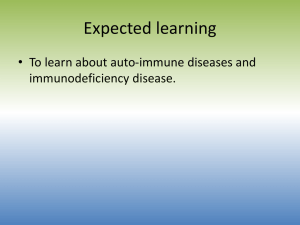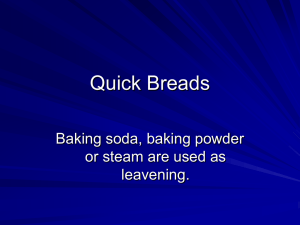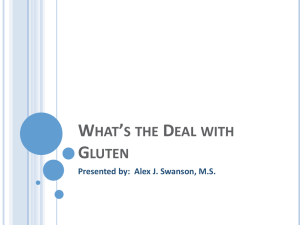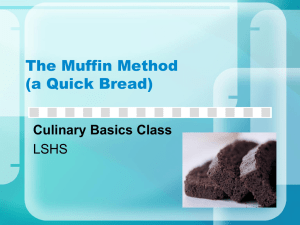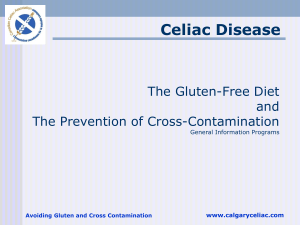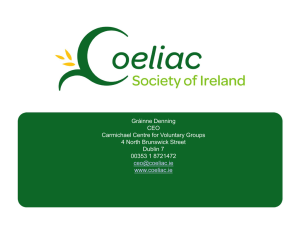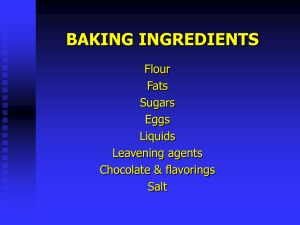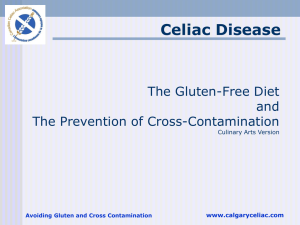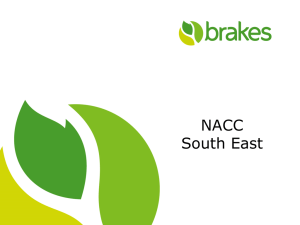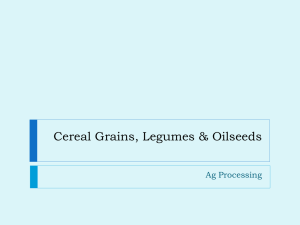Coeliac Society presentation
advertisement
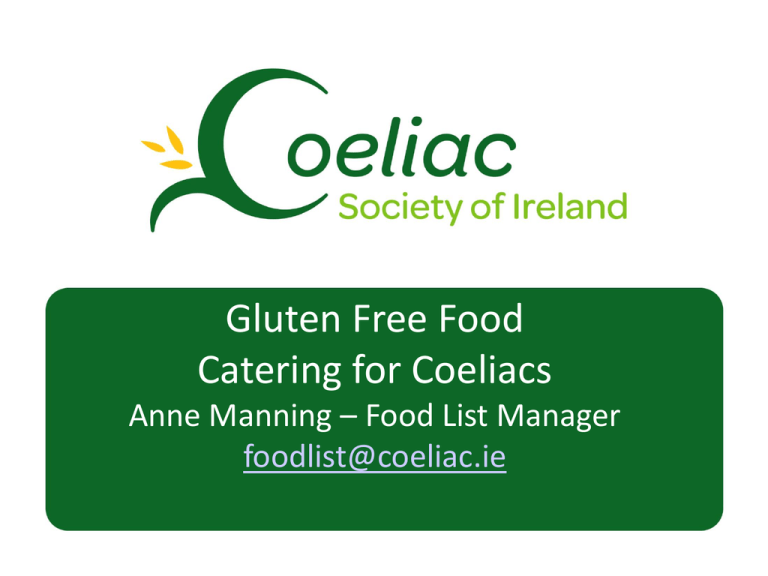
Gluten Free Food Catering for Coeliacs Anne Manning – Food List Manager foodlist@coeliac.ie What is Coeliac Disease? • Coeliac Disease is an autoimmune disease triggered by gluten. • A permanent intestinal intolerance to gluten. • with serious health consequences , if the disease is not diagnosed and treated properly. • Treatment - a strict gluten free diet for life • Affects 1% of the population – adults and children / 46,000 • How much Gluten? - Care must be taken to avoid cross contamination during food preparation as just one crumb can cause problems for some coeliacs. Coeliac Disease – the true picture Coeliac Disease - abnormal immune response to gluten. Damages the lining of the small intestine. Nutrients are not absorbed. Healthy normal villi in small intestine What is Gluten? • Gluten is (collective term) the proteins found in wheat, rye, barley, oats and their derivatives. Gluten gives that elasticity to dough. • • • • Wheat – gliadin Barley – hordein Rye – secalin Oats – avenin • Spelt, Kamut, Triticale, Emmer and Einkorn ancient forms of wheat, these grains are not suitable for coeliacs. • Gluten Containing Grains also include: Bulgar Wheat / Couscous / Durum Wheat / Semolina / Pearl Barley / Wheat Bran / Barley Malt / Farina / Oats Providing Gluten Free Meals Standard food safety practices In many cases you may already be applying these. • Ingredient selection and storage • Careful preparation to avoid cross contamination • Good hygiene standards • Communication to all staff. Ingredient Selection • Use naturally gluten free ingredients to create great menu choices. • Use the CSI Foodservice Manual to check for a particular gluten free product. • Purchase gluten free substitute ingredients from approved suppliers – use the CSI Foodservice Manual. • Know the ingredients in foods that you buy in as well as foods that you prepare from scratch. • Menu description accurate, descriptive and up to date. Foods containing Gluten All Breads chapattis, biscuits, crackers, cakes, pastries, scones, muffins, pizzas made from wheat, rye, oat or barley Wheat based Breakfast Cereals & Muesli. Corn Flakes & Rice Crispies containing barley malt extract. Meat & Poultry cooked in batter or bread-crumbs, sausages, black & white pudding, rissoles, haggis, breaded ham. flour. Milk & Milk Products Milk with added fibre, Pasta & Noodles yogurt & fromage frais Fresh, dried & canned containing muesli or wheat pasta, noodles. cereals Cheese & Eggs Cheese in coatings, Scotch Eggs Drinks – Malted Drinks, barley waters/squash, beer, lager, ales, stouts Puddings puddings made using wheat flour and or semolina Sauces – soya sauce Soups – Pearl Barley & Croutons Fish & Shellfish in batter or breadcrumbs/ fish cakes/ fish fingers Snacks made from wheat, rye, barley, oats. Ice Cream Cones & Wafers Vegetables & Potatoes in batter, breadcrumbs or dusted with flour, potato croquettes, fish & chips (chipper) Naturally Gluten Free Foods • • • • • • • • • • All Fresh Meat, Poultry and Fish (Rashers / Minced Meat) All Fresh Fruit & Vegetables / Potatoes Fresh Herbs Milk / Butter / Margarine / Cream / Natural Cheese / Natural Yogurt Eggs Pure Cooking Oils Sugar / Honey Jams / Marmalade / Honey / Golden Syrup / Molasses Rice Natural Nuts (unprocessed) • Naturally gluten free grains and flours can be contaminated. (Millet/Buckwheat/Quinoa/Tapioca /Potato / Rice /Gram Flour etc) Reliable brand should be used Separate GF Menu Benefits of Separate Gluten Free Menu: • Gives the gluten free diner confidence. • Chef has time to consider what can be prepared safely. • It gives time to check ingredients and suppliers. • It eliminates staff having to remember what is and is not available • It serves as a tangible reminder that this meal is special. • This meal has taken some extra awareness e.g. not putting the croutons on. Delivery & Storage Delivery: • Check that food delivered is the same brand that is normally used, different brands may have different ingredients and may not be gluten free. Storage: • Store Gluten free raw materials in a separate storeroom or in a clearly marked area. • Store in original packages with original labels. • If food is delivered in bulk and then decanted into other containers, ensure the labelling information goes with it. Food Preparation • Managing cross contamination is an important aspect of due diligence when catering for people with coeliac disease. • Cross contamination is the context of coeliac disease is the process by which a gluten free product loses that status because it comes into contact with something that is not gluten free. • Food preparation surface should be clean. • Utensils and equipment free of gluten, previously washed in hot water and detergent. • Colour coding is a great way of identifying which utensils are for gluten free food preparation. Food Preparation 2 Provide a separate toaster for gluten free bread or use Toastabags. Use separate butter and condiments pots to prevent crumb contamination. Small changes that can make a difference: Use cornflour or potato to thicken soups and gravies. Use a brand that is gluten free in mayonnaise/ketchup/ mustard/mayonnaise/ice cream/crisps etc. Use cornflour to dust meats and fish prior to cooking. Mints or Chocolates after meals – gluten free option. Biscuits in bedrooms - gluten free option. Gluten Free Beer available from the bar. Gluten Free Pizza Gluten Free Pizza Base: • • • • • • Safer option - use a ready made gluten free pizza base*. Ensure all toppings are gluten free* The GF pizza should be baked separately in dedicated oven. If dedicated oven is not available, then a dedicated screen is an alternative. Ensure staff are trained in the process of cooking the gluten free pizza. Keep gluten free pizza covered and labelled before serving. • Check in CSI Foodservice Manual Deep Fat Frying • Separate, clean oil should be used to fry chips and or gluten free battered fish or chicken. • Filtering oil or bringing the temperature of the oil to just below boiling point will not render the contaminated oil gluten free. • Having a separate fryer may be a realistic way to provide gluten free chips for coeliac customers. • Ensure the ketchup and sauces used with the chips is a suitable brand (check Foodservice Manual) • Gluten Free Batter: Ensure all equipment used is thoroughly clean, not contaminated with wheat flour. Gluten Free Batter should not be made with regular beer. (gluten free beer is available) Baking • Wheat flour can stay airborne for many hours and contaminate surfaces, utensils and uncovered gluten free food. • Gluten free baking in separate area or first thing in the morning when contamination from flour dust is at a minimum. • Use certified gluten free flours (check CSI Foodservice Manual) • Keep separate equipment for gluten free baking. • Cool in a separate area, covered and labelled separated from other products. • For display and service GF bakery items should be individually wrapped in portion packs and clearly labelled. • Purchasing GF substitute products: bread, cakes, cookies etc in portion packs will help eliminate the issue of cross contamination. (check CSI Foodservice Manual for details) Menu Planning Freezing Label & Wrap Purchasing Check GF Status Delivery Check Brands ordered AVOID GLUTEN Cooking – avoid Cross Contamination In Oven Portioning / Reheating / Serving – avoid Cross Contamination Good Hygiene Standards Storage Original Containers & Labels Food Preparation area completely clean Communication to all Staff Legislation Legislation relating to gluten free food Allergen Labelling Regulation – EU Regulation 1169/2011 Regulation 41/2009/EC – Labelling of the term “gluten free Making a Gluten Free Claim • In January 1st 2012 – ‘Gluten Free’ became a legal term. • Gluten Free refers to food that is 20ppm or less in gluten content. • You can make a gluten free claim by actively managing the level of gluten in your food. • It requires due diligence when it comes to controlling cross contamination. • It requires communicating with your staff so they understand their role in your compliance. Safefood - Restaurant Survey In 2009, Safefood conducted a restaurant survey. “Hold the Gluten” The project was designed to find out if coeliacs were being properly served by the catering industry: The risks posed by gluten and the appropriate control measures. 260 samples were taken from restaurants – ROI & N.Ireland 84% samples tested less than 10ppm Conclusions: In general, there is a good chance that a request for a gluten free meal can be accommodated in restaurants. This is especially true in restaurants that are listed on the CSI Restaurant List. Staff rely on the input and advice from the chef. The presence of gluten free menu choices did not guarantee risk free dining. Which labelling term can I use? The term gluten free is well established with both consumers and food manufacturers. If your food does not comply with this new legislation, you cannot make a gluten free claim. You can make a factual statement explaining that the ingredients you are using are gluten free but that the food served in your restaurant is made in a mixed food environment. Environmental Health is on hand to give advice on this new legislation. Testing of Gluten Free Foods • Testing of food to establish if it meets 20ppm or less isn't required by law to make a gluten free claim. • Some testing can be used to show that you have applied due diligence and validate your procedures. • Environmental Health can advise. Allergen Labelling – Pre-packaged • The EU Allergen Labelling law currently applies to all prepackaged foods, from 13th Dec allergy information must be provided for unpackaged foods. • Existing requirements for pre-packaged foods are retained with new requirements to emphasis allergenic foods in the ingredients list. Changes coming in Allergen Labelling • For the Catering Sector In Ireland, the information will need to be provided in a written format but can also be provided verbally at any time. Food Allergen Information for Non-Prepacked Foods Guidance Notes No 28 - available from FSAI • The regulation requires that information is provided about the use of allergenic ingredients in a food, a full ingredient list is not required. (information can be obtained from ingredient list and specifications) Allergen List – The big 14 Peanuts Nuts Milk Soya Mustard Lupin Eggs Fish Molluscs Cereals containing Gluten Sesame Celery Sulphur dioxide Crustaceans Foods containing allergens Eggs Fish Milk Nuts Celery in cakes, mousses, sauces, pasta, quiche, some meat products. Also in mayonnaise or brushed with egg. in some salad dressings, pizzas, relishes, fish sauces. Also in some soy sauce and Worcestershire sauces. in yoghurt, cream, cheese, butter, milk powders. Also check for foods glazed with milk in sauces, desserts, crackers, bread, ice cream, marzipan, ground almonds, nut oils. also includes celery stalks, leaves and seeds and celeriac. Also celery in salads, soups, celery salt and in some meat products. Foods containing allergens Mustard Peanuts Soya Sesame Sulphites including liquid mustard, mustard powder and mustard seeds, in salad dressings, marinades, soups, sauces, curries, meat products. in sauces, cakes, desserts. Also in groundnut oil and peanut flour. as tofu or bean curd, soya flour and textured soya protein, in soya ice creams, sauces, desserts, meat products, vegetarian products. in bread, tahini, hummus, sesame oil. in meat products, fruit juice drinks, dried fruit and vegetables. Also in wine and beer. Foods containing allergens Lupin Molluscs Gluten Crustaceans seeds and flour in some pastries and breads. include mussels, whelks, squid, land snails, oyster sauce. Cereals containing gluten – wheat, rye, oats and barley. Also flour, bread, pasta, cakes, pastry, meat products, sauces, soups, stock cubes, breadcrumbs, foods dusted with flour. include prawns, lobster, scampi, crab, shrimp paste. Further details Coeliac Society of Ireland, Carmichael House, 4 North Brunswick Street, Dublin 7. Telephone: +353-1-872 1471 Email: Copy of presentation can be emailed to chef.
